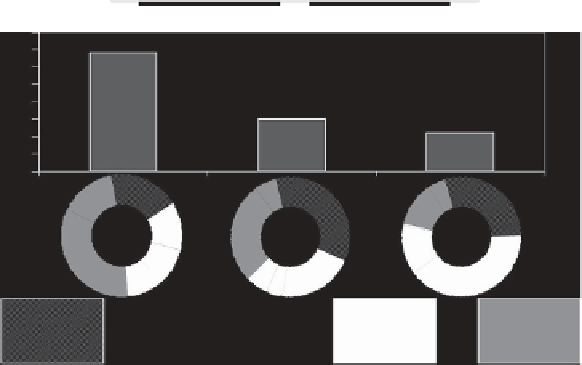Biomedical Engineering Reference
In-Depth Information
worked well in preventing the activation of protein C3 even at low molecular weights. This effect
was expected through designing nanoparticles coated with heparin, which is an inhibitor of comple-
ment system activation, thanks to an interference with factor H of the complement cascade (Nilsson
et al., 2007). Interestingly, the inhibiting property of heparin was maintained in nanoparticles
designed with a brush composed of a blend of dextran and heparin. Further analyses were pursued
on the nanoparticles coated with dextran sulfate, with heparin and with a blend of heparin and
dextran. The analysis of the proteins that adsorbed on these nanoparticles revealed a majority of
high-molecular weight proteins, including fibrinogen and immunoglobulin (Figure 18.9) (Labarre
et al., 2005).
The adsorption of these proteins onto the nanoparticle surface is in contradiction with their
capacity to prevent the activation of the complement system. It is also in contradiction with the
structure of a dense brush of polysaccharide chains forming the nanoparticle corona that should
exclude large proteins from adsorption onto nanoparticles. Although these results disagreed with
results obtained from previous studies carried out on almost neutral nanoparticles designed with a
corona composed of PEG and dextran, they agreed with those reported by Ballauff et al. investi-
gating protein adsorption on nanoparticles coated with polyelectrolyte brushes (Wittemann et al.,
2003; Welsch et al., 2013). These authors suggested that the adsorption of proteins resulted from
D1
H1
H2
Dextran sulfate
Mw 40 kDa
Heparin
Mw 17 kDa
Heparin Mw 17 kDa
Dextran Mw 70 kDa
Polysaccharide
D
H
(nm)
93
274
186
Zeta (mV)
Activation of C3
80
-42
-48
-24.0
60
40
20
0
Low Mw
proteins
lmmuno
globulin
Fibrinogen
High Mw proteins
lg (Mw 150 kDa)
Low Mw proteins
Apolipoproteins A1, A2, and C2
(Mw 28, 17, and 11 kDa)
Transthyretin (Mw 14 kDa)
Albumin (Mw 66 kDa)
Apolipoprotein J (Mw 70 kDa)
Transferrin (Mw 76.5 kDa)
Fibrinogen (Mw 340 kDa)
FIGURE 18.9
Protein adsorption on different negatively charged nanoparticles and corresponding status of
the activation of protein C3 of the complement system. The circles at the bottom represent the balance between
proteins of high molecular weight (>100 kDa) (dark gray and black) and low molecular weight (<100 kDa) (light
gray) that were found adsorbed at the nanoparticle surface after incubation in plasma. For proteins of high
molecular weight a difference was made between fibrinogen (in black) and immunoglobulins (in dark gray).

